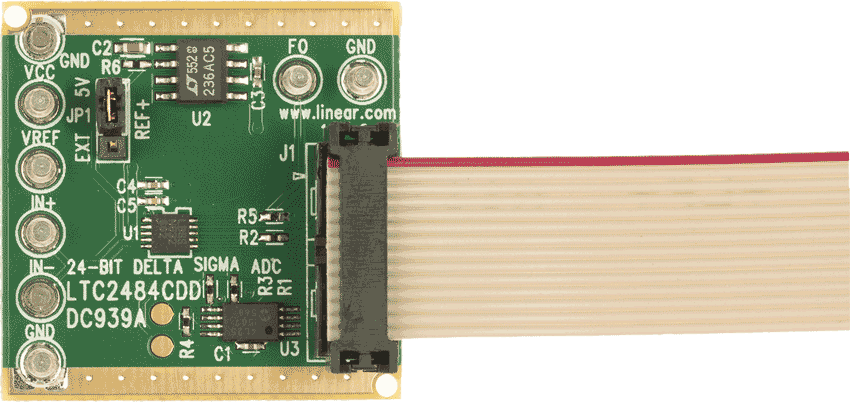LTC2484
PRODUCTION24-Bit ΔΣ ADC with Easy Drive Input Current Cancellation
- Part Models
- 4
- 1ku List Price
- Starting From $2.95
Part Details
- Easy Drive Technology Enables Rail-to-Rail Inputs with Zero Differential Input Current
- Directly Digitizes High Impedance Sensors with Full Accuracy
- 600nVRMS Noise
- GND to VCC Input/Reference Common Mode Range
- Programmable 50Hz, 60Hz or Simultaneous 50Hz/60Hz Rejection Mode
- 2ppm INL, No Missing Codes
- 1ppm Offset and 15ppm Total Unadjusted Error
- Selectable 2× Speed Mode (15Hz Using Internal Oscillator)
- No Latency: Digital Filter Settles in a Single Cycle
- Single Supply 2.7V to 5.5V Operation
- Internal Oscillator
- Available in a Tiny (3mm × 3mm) 10-Lead DFN Package
The LTC2484 combines a 24-bit No Latency ΔΣ™ analog-to-digital converter with patented Easy Drive™ technology. The patented sampling scheme eliminates dynamic input current errors and the shortcomings of on-chip buffering through automatic cancellation of differential input current. This allows large external source impedances and input signals with rail-to-rail input range to be directly digitized while maintaining exceptional DC accuracy.
The LTC2484 includes an on-chip oscillator. The LTC2484 can be configured to reject line frequencies. 50Hz, 60Hz or simultaneous 50Hz/60Hz line frequency rejection can be selected as well as a 2× speed-up mode.
The LTC2484 allows a wide common mode input range (0V to VCC) independent of the reference voltage. The reference can be as low as 100mV or can be tied directly to VCC. The LTC2484 includes an on-chip trimmed oscillator, eliminating the need for external crystals or oscillators. Absolute accuracy and low drift are automatically maintained through continuous, transparent, offset and full-scale calibration.
Applications
- Direct Sensor Digitizer
- Weight Scales
- Direct Temperature Measurement
- Strain Gauge Transducers
- Instrumentation
- Industrial Process Control
- DVMs and Meters
Documentation
Data Sheet 1
Reliability Data 1
User Guide 1
Design Note 2
Technical Articles 4
Product Selector Card 2
ADI has always placed the highest emphasis on delivering products that meet the maximum levels of quality and reliability. We achieve this by incorporating quality and reliability checks in every scope of product and process design, and in the manufacturing process as well. "Zero defects" for shipped products is always our goal. View our quality and reliability program and certifications for more information.
| Part Model | Pin/Package Drawing | Documentation | CAD Symbols, Footprints, and 3D Models |
|---|---|---|---|
| LTC2484CDD#PBF | 10-Lead DFN (3mm x 3mm w/ EP) | ||
| LTC2484CDD#TRPBF | 10-Lead DFN (3mm x 3mm w/ EP) | ||
| LTC2484IDD#PBF | 10-Lead DFN (3mm x 3mm w/ EP) | ||
| LTC2484IDD#TRPBF | 10-Lead DFN (3mm x 3mm w/ EP) |
| Part Models | Product Lifecycle | PCN |
|---|---|---|
|
Jun 30, 2020 - 20_0244 Notification of Wafer Fab Location Change for 0.6µm CMOS Process Devices from ADI Milpitas (Hillview) to Vanguard Int. (Taiwan) |
||
| LTC2484CDD#PBF | PRODUCTION | |
| LTC2484CDD#TRPBF | PRODUCTION | |
| LTC2484IDD#PBF | PRODUCTION | |
| LTC2484IDD#TRPBF | PRODUCTION | |
This is the most up-to-date revision of the Data Sheet.
Software Resources
Can't find the software or driver you need?
Request a Driver/SoftwareHardware Ecosystem
| Parts | Product Life Cycle | Description |
|---|---|---|
| Analog Temperature Sensors 1 | ||
| LTC2995 | PRODUCTION | Temperature Sensor and Dual Voltage Monitor with Alert Outputs |
| Precision Resistor Network 1 | ||
| LT5400 | RECOMMENDED FOR NEW DESIGNS | Quad Matched Resistor Network |
| Series Voltage References 1 | ||
| LTC6655 | PRODUCTION | 0.25ppm Noise, Low Drift Precision References |
| TimerBlox 1 | ||
| LTC6991 | PRODUCTION | TimerBlox: Resettable, Low Frequency Oscillator |
Tools & Simulations
Linduino 5
Linduino is Analog Devices’ Arduino compatible system for developing and distributing firmware libraries and example code for our integrated circuits. Each Linduino-supported product includes an example main program, defined in the LTSketchbook/Part Number folder and driver code, defined in the LTSketchbook/libraries folder.
Linduino code repository on GitHub and instructions on how to use the code.





